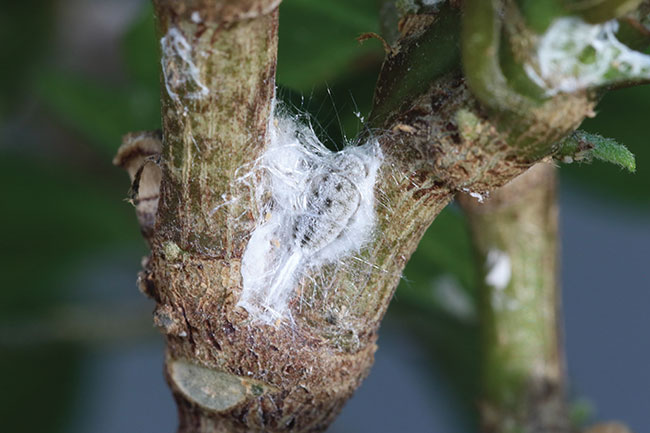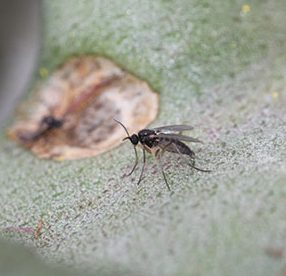
Features
Biocontrols
Crop Protection
Flowers
Tropical foliage pests to watch out for
The lush foliage of tropical plants attracts both wanted and unwanted attention. Here are key pests to look out for in the greenhouse and at retail.
February 22, 2021 By Suzanne Wainwright-Evans
 The striped mealybug (Ferrisia virgata) can be a pest of tropicals. Be sure to check the trunks and stems of hibiscus where they are often found. All photos: S. Wainwright-Evans
The striped mealybug (Ferrisia virgata) can be a pest of tropicals. Be sure to check the trunks and stems of hibiscus where they are often found. All photos: S. Wainwright-Evans Anytime you have plants, there’s always a risk of insects or mites feeding on them. Tropical plants have particularly lush foliage that are very nutritious to many pests. That’s why it is important to know which pests you have, so you can target them using the best possible solutions.
Sometimes, the solution is a pesticide spray program or a biocontrol program. Other times, it may be a combination of both. If you’re using a combination program, make sure you work closely with someone who is well-versed in the biological control agents’ pesticide compatibility. Keep fungicides in mind because some can have negative impacts on biological control agents, and they’re easy to overlook when developing a program.
Here are some key pests you might come across when working with tropical plants.
Twospotted spider mites
One of the more common pests of tropical plants is the twospotted spider mite (TSSM, Tetranychus urticae). It is considered a cosmopolitan pest; meaning it’s found in many parts of the world. It can feed on a number of tropical plants like dieffenbachia, alocasia, assorted palm species, and crotons.
TSSM feed by sticking its mouth parts into the plant cells of the leaves and sucking out the contents. This is what causes the typical light-coloured speckling on damaged leaves. However, not all plants react in the same way to feeding damage. On crotons, the feeding damage actually causes the plant to turn red.
TSSM are easy to scout for; simply look at the undersides of leaves. You not only want to look for adults, but also their eggs. Once detected, TSSM can be managed using biological control agents or pesticide applications. You will need to look at your specific situation to decide which option is best for you.
In a controlled environment like a greenhouse, pesticides may be an effective option as long as you can get good spray coverage and the TSSM are not resistant to the miticide. Because tropical foliage plants can grow very dense, good spray coverage is very important. Most miticides either work on contact or are translaminar, moving just a short distance in the leaf. When selecting a miticide, make sure you take note of which life stages are actually controlled by the product. Some products will only kill immature stages and adults, while others will also target their eggs.
As getting good spray coverage can be a challenge, many growers of tropical foliage opt to use predatory mites to control this pest. The predatory mites can climb down into the plants’ canopy, finding all life stages of the TSSM and stopping them in their tracks. They also work 24/7.
There are many species of predatory mites on the market that feed on TSSM, so it’s best to work with someone who can help guide you to the best species for your situation. The most commonly used species are Phytoseiulus persimilis and Neoseiulus californicus because they specifically target TSSM, are easy to obtain and are economical.
Insect pests
There are many insects that like to feed on tropical foliage. Some are pretty obvious, like caterpillars, where you can see the chewing damage. But we do not see a lot of caterpillar damage in tropical production areas. Other pests that have piercing / sucking mouthparts can be a little more challenging to diagnose and are more common.
Aphids, whiteflies and scales all have piercing sucking mouthparts. Their mouths are like straws that stick into plant material for sucking out the sap. Because of this, they can produce excessive amounts of sugars which they excrete, leaving a sticky substance on the plant. As aphids feed, they can cause distortion in new plant growth and leave white cast skins on the plant. These are often mistaken for whiteflies. It’s always important to check and make sure you have a live active population of a pest before treating it, and not just the remaining dead bodies from an old infestation.
Aphids: There are many species of aphids found on tropical crops, so best to get them identified if you find them. They have a pretty wide host range, including hibiscus, which is growing in popularity. If you can get good spray coverage, contact pesticides may be one option for control. But because coverage is often an issue, growers typically want to use systemic pesticides. These can be effective as long as the pest is not resistant to the product. There are also more limitations on systemic use due to pollinator issues.
Biological control is another option for aphids, but this is more for use on the production side, not for remediating a problem in a holding area or retail environment. Biological control is also designed to be used as a preventative treatment, not necessarily a curative one. There are many species of parasitoids and predators for aphid management on the market today. If you have an aphid issue, talk to your biological control supplier and see if beneficials would work for your particular situation.
Whiteflies are not super common on tropical foliage, but they have been a problem for Ficus plants in recent years due to the specific species, ficus whitefly (Singhiella simplex). This species is specific to Ficus and does not move into other foliage crops. It can be treated with pesticides, but there are no commercial biological control agents for this species.
Scales are a bit more common on tropical foliage, and are found on palms, ficus, schefflera as well as other plants. The scales can either be soft or armoured. Soft scales are the ones that produce a sticky substance called ‘honeydew’, while armoured scales do not.
Horticultural oils have proven to be very effective in managing scales, but keep in mind that once the scale is dead, the body will still remain on the plant material and may need to be physically removed. In addition to oils, insect growth regulators and systemic pesticides have also been proven to work well in the management of this pest. Unfortunately, there are no good biocontrol agents for scales on the market at this time.
Mealybugs have become one of the biggest pests in tropical foliage in recent years. Mealybugs are actually a type of soft scale. They have the same piercing / sucking mouthparts and will produce honeydew. There are many different species, but their biology is somewhat similar.
The challenge can often be finding them on plants because they can hide well, tucked into leaf petioles. There are even species of mealybugs that live on roots of plants. For mealybugs that are exposed, horticultural oils and insecticidal soaps can perform well on contact. Because they’re often tucked into folds, contact products have a hard time reaching them and systemic pesticides are needed.
Sometimes you need to take a hard look at the economics of control. You may decide that it’s cheaper to just get rid of the infected plants. When it comes to biological control, it’s typically not very economical to use beneficials for mealybugs on tropical foliage. Yes, there can be exceptions, such as in botanical gardens, specimen plants, or very long-term crops. In the long run, pesticides are often less expensive and more effective for mealybug control in production or re-wholesale situations.
Thrips: Another pest we may see are thrips. Their mouthparts are a little different from piercing / sucking insects. Instead, thrips have rasping mouthparts that scrape the leaf tissue. The ones found in tropical foliage are usually a different species. Thrips found in other floriculture crops tend to be the western flower thrips (Frankliniella occidentalis). On tropical foliage plants, we see species like chilli thrips (Scirtothrips dorsalis), poinsettia thrips (Echinothrips americanus), and greenhouse thrips (Heliothrips haemorrhoidalis), among others.
Thrips can prove to be a challenging problem to manage because they lay their eggs inside the plant tissues where pesticides cannot reach them, not even systemics! Some species also pupate in the soil, so a conventional spray program cannot target this life stage.
If you are considering biological control, be aware that not all of these thrips species can be managed through augmented biocontrol (i.e. buying and releasing beneficials). The poinsettia thrips is an excellent example, and it feeds on a lot more than just poinsettia. This thrips species is very good at defending itself, and the predatory mites normally used to manage other thrips species cannot get them under control. Poinsettia thrips does not pupate in the soil, so beneficials that we often use for managing thrips, like beneficial nematodes, do not work. Beneficial nematodes live in the soil and poinsettia thrips completes its entire life cycle in the plant canopy. This is why it’s important to first identify the thrips species you are dealing with before attempting to manage it.
For managing thrips, many growers have found success in using combination programs of pesticides and biological control agents. Many of the newer pesticides (including microbial products) tend to be more compatible with biological control agents than pesticides of the past. Management choices will depend on which specific species you’re dealing with.

Fungus gnats may not seem problematic, but they can be a real nuisance at retail or in someone’s home.
Fungus gnats: Another industry-wide pest is the fungus gnat. Tropical foliage tends to require more irrigation, often resulting in a nice, damp environment for fungus gnat larvae to live in. Normally, fungus gnats are merely considered a nuisance in larger plants, but they can vector plant pathogens. If these plants are destined for a retail environment or an interiorscape, fungus gnats need to be managed because they can become an annoyance to customers. Luckily these gnats are easy to manage.
Many growers are already using beneficial nematodes (Steinernema feltiae). They’re easy to apply, economical, and you do not have to worry about resistance issues. There is also no re-entry interval (REI) when using them as they are exempt from pesticide regulations, just like the predatory mites, predators and parasitoids. There are other biological control agents that can be applied to media, like Stratiolaelaps scimitus (mite) and Dalotia coriaria (beetle). These help provide control of fungus gnat larva and manage other soil-dwelling pests.
Always inspect new plants
It is really important to have a good scouting program for detecting pests early. If you’re bringing in tropical foliage, make sure you have a good protocol in place for inspecting incoming plant material. This should include all plant parts, along with the growing media. It is also wise to have a quarantine area for temporarily holding incoming plants, just to make sure that pests did not arrive with the new plants. Preventing the spread of an incoming pest to the rest of your facility is much easier than trying to control them later.
Suzanne Wainwright-Evans is a horticultural entomologist and owner of Buglady Consulting. She can be reached at Info@Bugladyconsulting.com.
Print this page